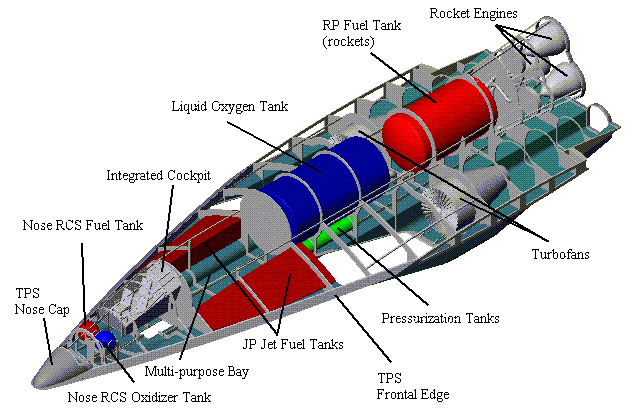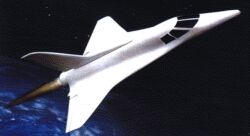
| Home | Bottom |
| SPACE | TRANSPORT: | Spacecraft Tech : | HTOL SSTO |
A RLV that takes off and lands horizontally like conventional planes - a true aerospaceplane, is a dream of many aerospace designers. It is expected that it will be more practical and safer than VTOL craft.
Building such a spacecraft will be a huge challenge to out present know how. Most current concpts aim only for sub-orbit (like x-prize contestants), which is far easier to achieve. But will these have enough utility to justify them. Afterall, there is little long term use of a vehicle that only serves to give people expensive joyrides to space.

Getting to orbit is quite a challenge, and doing it HTOL-SSTO is complexing it further. This being the reason why some of the current concepts are 2 stage designs. See HTOL TSTO. All X-Prize htol-ssto designs are sub-orbital only.
Another variation of this concept is what is popularly called a 'One and a Half' Stage to Orbit design as seen in the Black Horse and Pathfinder.
We can classify HTOL SSTO spacecraft on the basis of propulsion :
A rocket only vehicle would light up its rocket right from the runway and power ahed till in space. However, reaching orbit relying only on current rocket technology is not feasible, if not impossible. The fuel+oxidiser weight becomes too high. Another problem is that the air friction will heat up the spacecraft beyond control.
The solution to this problem is expected to come in air-breathing rocket engines like scramjets. These suck in air from the atmosphere even at great heights and at hypersonic speeds so that the vehicle has to carry the oxidiser enough for time outside the atmosphere. These vehicles too will face the problem of heat build-up.
The HyperSoar will escape this head-ache of excessive heat by skipping across the air throughout the trip, while the engines are off. HyperSoar can do this only because it will have jets that can take in air at high altitudes.

Such spacecraft will take-off from the ground under the power of ordinary subsonic turbofans, reach a desired altitude where they will switch their jets to rockets and blast off. This sounds logical enough, but there dobts whether such vehicles will have the efficiency to reach orbit. The combined weight of both types of engines add extra weight. Another being that the end product will be a bit complex due to so many different systems on board.
Many X-Prize contenders hope to operate exactly in this manner, but one must remember that there is a huge difference between 100 kms and orbit.
The diagram given below of the Cosmos Mariner is an excellent representation of how a craft having both jets and rocket engines might be constructed. The jet engines have been tightly integrated into the main body since they will pose a problem while re-entry and also spoil the aerodynamics of 'spaceship'. Efficiency is critical to performance. Note that the only cargo on the craft are the passengers.

Weight is very, very crucial in the launch business. Currently in takes 10,000 bucks per pound to get stuff to orbit. Getting to orbit is very difficult, and every ounce counts. Even if money were no problem, the hardware required gets exponentionally complex with size.
'One and a Half Stages' is an innovative HTOL design which uses in-flight refuelling of a single-stage vehicle before shooting for space.
Such a Spacecraft will take off with no liquid oxygen in its tanks, using jets to reach a high altitude. By this time most of the jet fuel has been used thus making it lighter. It will then rendezvous with a tanker which will supply it LOX inflight. The Spacecraft can then effectively "take off" with full tanks at high altitude. The liquid Hydrogen or other fuel will be on the vehicle before take-off. The concept is innovative and practical. It does reduces problems due to take-off weight to a large extent.
In-flight refuelling is practiced routinely by airforces around the world and so safety should not be a problem. However, the technology to transfer fuel at such an extremely low temperature does not exist(LOX has to be stored at extremely low temperatures to liquify it).
Also See :
| Spacecraft Tech | : | HTOL TSTO |
| Spacecraft Tech | : | Air Breathing Rockets |
| X-Prize | : | HTOL SSTO vehicles |
| X-Prize | : | Pathfinder |
| Spacecraft | : | AVATAR |
| Spacecraft | : | HyperSoar |
| Spacecraft | : | MiG-2000 |
| Spacecraft | : | Tu-2000 |
| gbnet.net/orgs/skylon : Reaction Engines Ltd, people behind Skylon |
| im.lcs.mit.edu/bh : Mitchell Clapp's Black Horse |
| rocketplane.com : X-Prize Contestant Pioneer Rocketplane |
| bristolspaceplanes.com : X-Prize Contestant Bristol Spaceplanes (UK) |
| thirftyspace.com : X-Prize Contestant CFFC |
| tour2space.com : X-Prize Contestant Pan Aero |

Mail ST at [email protected] . Your suggestions are welcome.
| [ Home ] | [ Aircraft ] | [ Explore Space ] | [ Space Stations] | [ Spacecraft Tech ] | [ Spacecraft ] | [ X-Prize ] |
| © Space Transport | Top |